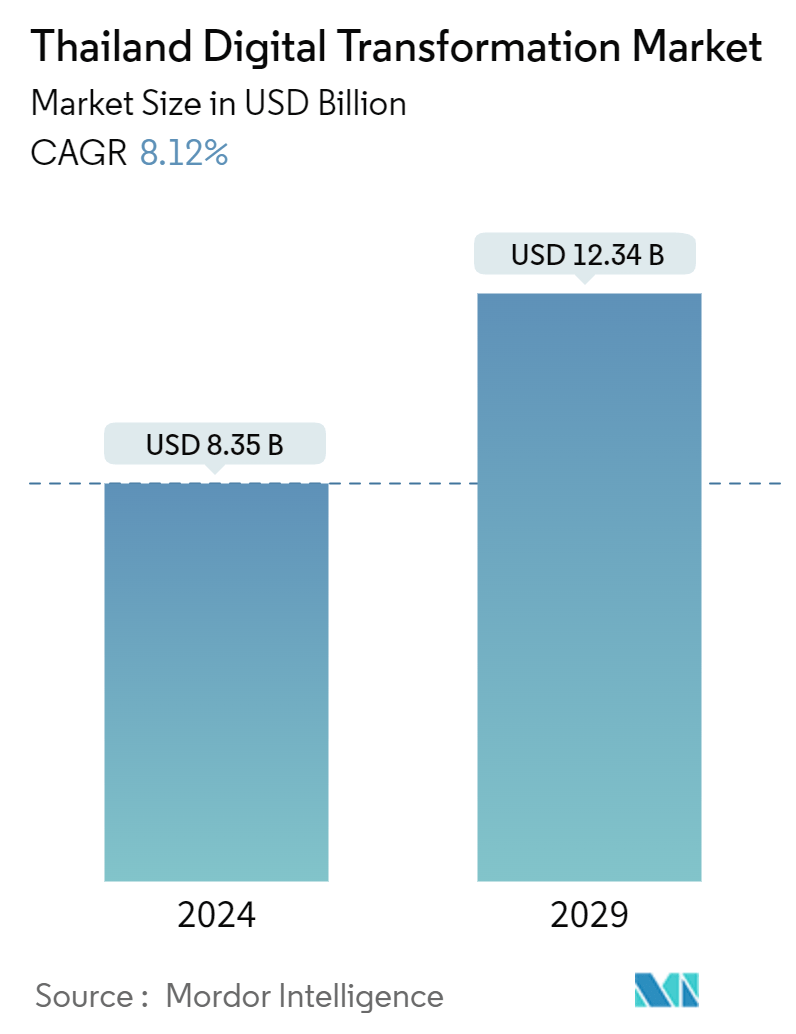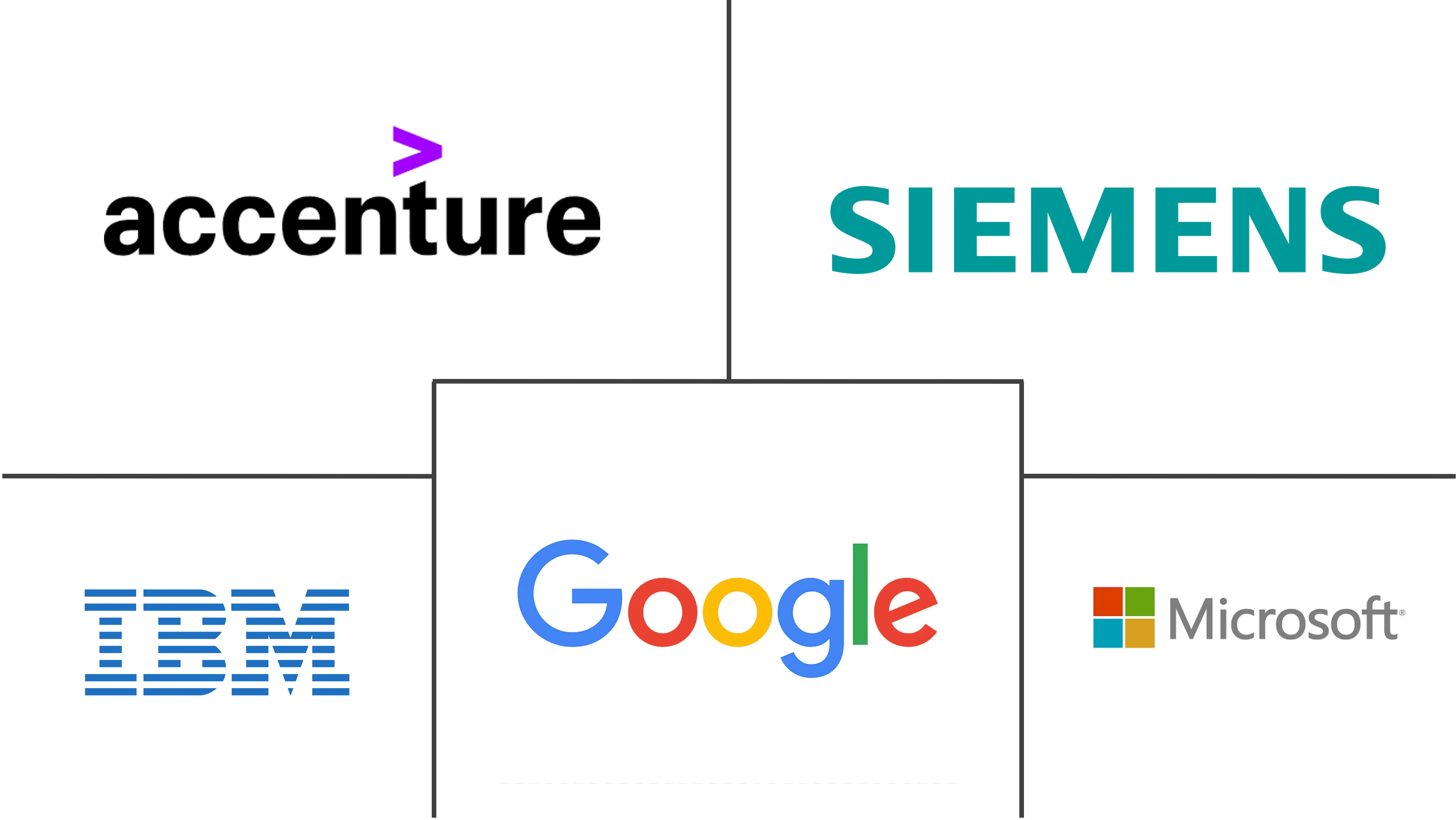Market Size of Thailand Digital Transformation Industry

| Study Period | 2019 - 2029 |
| Base Year For Estimation | 2023 |
| Market Size (2024) | USD 8.35 Billion |
| Market Size (2029) | USD 12.34 Billion |
| CAGR (2024 - 2029) | 8.12 % |
| Market Concentration | Low |
Major Players
*Disclaimer: Major Players sorted in no particular order |
Thailand Digital Transformation Market Analysis
The Thailand Digital Transformation Market size is estimated at USD 8.35 billion in 2024, and is expected to reach USD 12.34 billion by 2029, growing at a CAGR of 8.12% during the forecast period (2024-2029).
Thailand Digital transformation market is experiencing robust growth driven by rapid technological adoption, increasing internet penetration, and supportive government policies.
• Technological advancements, particularly in AI, ML, IoT, and cloud computing, are spearheading digital transformations across various sectors. These advancements enable businesses to optimize operations, enhance customer engagement, and revolutionize their business models.
• The Thai government is actively driving digital transformation through various initiatives. The 'Thailand 4.0' policy is at the forefront, designed to elevate the nation to a high-income status by leveraging innovation and technology. This strategy emphasizes the development of smart cities, the enhancement of digital skills, and the cultivation of a robust digital economy. The 'Eastern Economic Corridor (EEC)' project is pivotal, complementing this with a vision to pivot the region into a center for technological innovation and advanced industries.
• Businesses in Thailand are swiftly embracing cutting-edge technologies to maintain their competitive edge. Cloud computing, favored for its scalability and cost-efficiency, is streamlining operations. Furthermore, the adoption of big data analytics and AI is empowering companies to make data-informed decisions. Notably, financial institutions are utilizing AI for fraud detection and personalized services, while retailers harness big data for precise marketing and inventory management.
• Recognizing the surging demand for digital services, Thailand is significantly bolstering its digital infrastructure. The rollout of 5G networks is a game-changer, promising heightened connectivity and paving the way for innovations like autonomous vehicles and telemedicine. Concurrently, the nation's broadband penetration is rising, bridging the digital divide between urban and rural areas.
• However, amidst these advancements, challenges loom. A pronounced digital skills gap poses a significant hurdle, with a dearth of professionals adept at managing advanced technologies. Moreover, as digitalization deepens, so do concerns over cybersecurity increases. Safeguarding data privacy and fortifying critical infrastructure against cyber threats are imperative tasks to sustain the growth of the digital economy.
Thailand Digital Transformation Industry Segmentation
Digital transformation is the process of incorporating digital technologies such as analytics, artificial intelligence and machine learning, extended reality (XR), Iot, industrial robotics, blockchain, additive manufacturing/3D printing, cybersecurity, cloud and edge computing, and others (digital Twin, mobility, and connectivity) in various end-user industries.
The Thailand digital transformation market is segmented by type (analytics, artificial intelligence, and machine learning, extended reality (XR), IoT, industrial robotics, blockchain, additive manufacturing/3d printing, cybersecurity, cloud, and edge computing, and others [digital twin, mobility, and connectivity]), end-user industry (manufacturing, oil, gas and utilities, retail & e-commerce, transportation and logistics, healthcare, BFSI, telecom and IT, government and public sector, and others). The market sizes and forecasts are provided in terms of value (USD) for the segments.
| By Type | |||||||
| |||||||
| |||||||
| |||||||
| |||||||
| |||||||
| |||||||
| |||||||
| |||||||
|
| By End-User Industry | |
| Manufacturing | |
| Oil, Gas and Utilities | |
| Retail & e-commerce | |
| Transportation and Logistics | |
| Healthcare | |
| BFSI | |
| Telecom and IT | |
| Government and Public Sector | |
| Others (Education, Media & Entertainment, Environment etc) |
Thailand Digital Transformation Market Size Summary
The Thailand Digital Transformation Market is experiencing significant growth, driven by rapid technological advancements and supportive government initiatives. The adoption of technologies such as artificial intelligence, machine learning, Internet of Things, and cloud computing is transforming various sectors, enabling businesses to optimize operations and enhance customer engagement. The Thai government's 'Thailand 4.0' policy and the Eastern Economic Corridor project are pivotal in this transformation, aiming to elevate the nation to a high-income status through innovation and technology. These initiatives focus on developing smart cities, enhancing digital skills, and fostering a robust digital economy. The rollout of 5G networks and the increasing broadband penetration are further bolstering the digital infrastructure, bridging the digital divide between urban and rural areas.
Despite the promising growth, challenges such as a digital skills gap and cybersecurity concerns remain. The Thai government is actively addressing these issues through its 20-year Digital Thailand Plan, which aims to position Thailand as a digital leader in Southeast Asia. The plan is structured in phases, with the current phase focusing on complete digital transformation by 2027. Key players in the market, including Ericsson and Microsoft, are enhancing their service offerings through strategic partnerships and innovations. These efforts are complemented by initiatives to prepare the workforce for the digital age, ensuring that Thailand remains competitive in the global digital economy.
Thailand Digital Transformation Market Size - Table of Contents
-
1. MARKET DYNAMICS
-
1.1 Market Drivers
-
1.1.1 Increase in the adoption of big data analytics and other technologies in the country/region
-
1.1.2 The rapid proliferation of mobile devices and apps
-
-
1.2 Market Restraints
-
1.2.1 Concerns about the Privacy and Security of Information
-
-
-
2. MARKET SEGMENTATION
-
2.1 By Type
-
2.1.1 Analytics, Artificial Intelligence and Machine Learning
-
2.1.1.1 Current Market Scenario and Market Projections for the Forecast Period
-
2.1.1.2 Key Growth Influencers (Drivers, Challenges, and Opportunities)
-
2.1.1.3 Use Case Analysis
-
2.1.1.4 Market Outlook
-
-
2.1.2 Extended Reality (XR)
-
2.1.2.1 Current Market Scenario and Market Projections for the Forecast Period
-
2.1.2.2 Key Growth Influencers (Drivers, Challenges, and Opportunities)
-
2.1.2.3 Use Case Analysis
-
2.1.2.4 Market Outlook
-
-
2.1.3 IoT
-
2.1.3.1 Current Market Scenario and Market Projections for the Forecast Period
-
2.1.3.2 Key Growth Influencers (Drivers, Challenges, and Opportunities)
-
2.1.3.3 Use Case Analysis
-
2.1.3.4 Market Outlook
-
-
2.1.4 Industrial Robotics
-
2.1.4.1 Current Market Scenario and Market Projections for the Forecast Period
-
2.1.4.2 Key Growth Influencers (Drivers, Challenges, and Opportunities)
-
2.1.4.3 Use Case Analysis
-
2.1.4.4 Market Outlook
-
-
2.1.5 Blockchain
-
2.1.5.1 Current Market Scenario and Market Projections for the Forecast Period
-
2.1.5.2 Key Growth Influencers (Drivers, Challenges, and Opportunities)
-
2.1.5.3 Market Outlook
-
-
2.1.6 Additive Manufacturing/3D Printing
-
2.1.6.1 Current Market Scenario and Market Projections for the Forecast Period
-
2.1.6.2 Key Growth Influencers (Drivers, Challenges, and Opportunities)
-
2.1.6.3 Use Case Analysis
-
2.1.6.4 Market Outlook
-
-
2.1.7 Cybersecurity
-
2.1.7.1 Current Market Scenario and Market Projections for the Forecast Period
-
2.1.7.2 Key Growth Influencers (Drivers, Challenges, and Opportunities)
-
2.1.7.3 Use Case Analysis
-
2.1.7.4 Market Outlook
-
-
2.1.8 Cloud and Edge Computing
-
2.1.8.1 Current Market Scenario and Market Projections for the Forecast Period
-
2.1.8.2 Key Growth Influencers (Drivers, Challenges, and Opportunities)
-
2.1.8.3 Use Case Analysis
-
2.1.8.4 Market Outlook
-
-
2.1.9 Others (digital twin, mobility, and connectivity)
-
2.1.9.1 Current Market Scenario and Market Projections for the Forecast Period
-
2.1.9.2 Key Growth Influencers (Drivers, Challenges, and Opportunities)
-
2.1.9.3 Market Breakdown by Type (Digital Twin, Mobility and Connectivity)
-
2.1.9.4 Use Case Analysis
-
2.1.9.5 Market Outlook
-
-
-
2.2 By End-User Industry
-
2.2.1 Manufacturing
-
2.2.2 Oil, Gas and Utilities
-
2.2.3 Retail & e-commerce
-
2.2.4 Transportation and Logistics
-
2.2.5 Healthcare
-
2.2.6 BFSI
-
2.2.7 Telecom and IT
-
2.2.8 Government and Public Sector
-
2.2.9 Others (Education, Media & Entertainment, Environment etc)
-
-
Thailand Digital Transformation Market Size FAQs
How big is the Thailand Digital Transformation Market?
The Thailand Digital Transformation Market size is expected to reach USD 8.35 billion in 2024 and grow at a CAGR of 8.12% to reach USD 12.34 billion by 2029.
What is the current Thailand Digital Transformation Market size?
In 2024, the Thailand Digital Transformation Market size is expected to reach USD 8.35 billion.

